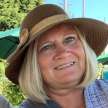Asking for Help is Difficult but It is Harder to Survive Alone
Life After My Daughter Had a Stroke

I was thirty days from retirement, enjoying a weekend away at our cabin retreat, the place I call home. All seem right with the world. Then the phone rang. Yes, I acknowledge a 7 a.m. Sunday morning wake-up call creates an abrupt awakening, but it happens sometimes. However, when my husband answered, I heard long pauses and tones of concern. Thinking something had happened to my 84-year-old father, I listened attentively. When Randy used the pronoun “she” alarms blared. Something had happened to one of my babies.
By the end of the call, I knew it was Kari, our 33-year-old daughter.
The situation was critical because my eavesdropping only deciphered more unknowns: life-threatening, sudden, undefined, unidentified. Kari lay in the ICU without the ability to talk or move her right side — without her mother.
Randy and I dressed, piled in the car without bothering to pack anything except the phones and our dog. We drove down the mountain road we had traveled many times before. Only this time we soared around curves and bends, memorized from extensive navigation the past 25 years. Dagney was handed off to Uncle Ron as his house resided between the cabin and the hospital.
Anybody who has visited a patient in ICU knows it is a traumatic experience to see a loved one hooked to tubes extending from numerous body points, feeding into one unit that acts as a brain for thoughts and movements. Having lived this nightmare before with different characters, terror stabbed my heart — not surprise.
With my daughter as the protagonist, my breathing became shallow, my heart pounded violently, and my brain seized on worst case scenarios. My bodily functions didn’t return to normal until many days later, but the stress tapered when our baby looked at us with recognition and smiled.
She was in ICU five days, and in the hospital a total of eleven days.
Following doctors’ recommendations, Kari transferred to St. Luke’s Rehabilitation Hospital for an additional thirty-two days, bringing the total number of days institutionalized to forty-three. During that time, her husband, Dan, and I defiantly sat by her side. Our mission to protect her remained unnamed but clear.
Forty-three days is not a lot in the course of a lifetime, but as our family lived the nightmare, each day following Kari’s stroke moved in slow motion. Waiting prompted fear. The unknown paralyzed emotions. When our daughter experienced a traumatic brain injury, a stroke, logic no longer existed.
The radiologist, Dr. Peal, entered the room to discuss test results; the medical explanations sounded like lines from the poem, “Jaberwocky” by Lewis Carroll .
’ Twas brillig, and the slithy toves
Did gyre and gimble in the wabe;
All mimsy were the borogoves,
And the mome raths outgrabe.
At that moment, he made about as much sense as those lines while instilling as much dread. We listened, mouths agape, minds filled with unending questions, wondering which to ask. “What is a . . .? Why did . . ? ? How can . . ? ? ? ? ?”
Dr. Peal’s compassion provided wisdom more valuable than the diagnosis. He encouraged us not to expect quick results because overcoming a stroke takes months — years. Let the hospital staff do their job and do not hurry the process.
“It is a long journey. Think of it as a marathon, not a sprint. Take care of yourself.”
We had been in the hospital so many hours, time held no value. The first day, my husband and I never even thought about eating; our needs became secondary. Eventually, with coercion, we ventured to the cafeteria, attempted to eat a bowl of tomato soup, only to discover it was squash. We left the full bowls on the table with our appetites. Yes, labels probably provided that information, but reading would have required a higher level of consciousness.
When my sister-in-law arrived, she ordered us home to sleep with strict instructions, “Take care of yourselves.”
We went home and with the assistance of two over the counter sleeping pills, I slept. My husband’s body absorbed the rest as if coma induced. In a conversation driving back to the hospital the next morning, I commented on my exhaustion during the ride home the previous night. Randy pointed out I had driven my own car. OMG! I realized concerned, I possessed no memory of driving home — no recollection at all.
Our youngest daughter, Kat, called often to check on the situation but I think she was mostly checking on her dad and me, “What have you eaten? Did you sleep? Are you taking care of yourself?”
My immediate response, “Yes, don’t worry about us.”
Even the social worker asked the dreaded question, “Are you taking care of yourself?”
I wanted to scream.
“It’s not about me. My daughter is laying in a bed. She can’t talk or move her right side. I must take care of her. I can’t even begin to take care of myself.”
Instead I said, “I’m fine.”
Not until I sat and talked with my granddaughter, Kari’s oldest child, and her other grandmother did the situation turn surreal. In front of my granddaughter, Grandma Virnene asked, “How are you doing?”
There was THAT question, again! Unable to avoid it, I stiffly replied, “I’m fine — just fine.”
To change the focus I asked Jodi, “How are you?”
This mature 12-year-old responded like a parrot, “I’m fine — just fine.” Her four simple words slapped me in the face. She lied.
We were all emotionally broken. At that moment I confessed and explained how I really felt while looking her in the eye, “OK. I will tell the truth. I am not fine! This situation sucks and maybe we should all be honest and share our pain.”
By modeling strength, persistence and optimism without sharing my pain, I stifled emotions.
Thereby, teaching Jodi to do the same. Experience taught that emotions bottled too long exploded. By ignoring grief, it grew stronger. To conquer and control the suffering, we had to acknowledge it, support each other, and stand strong.
After that night, dialogue flowed easier — healthier. I feared sharing my pain would expose my wounds, force me to lose control, but in fact, sharing allowed me to garnish comfort and in return offer comfort. I felt less alone.
Each person must identify their own coping mechanism.
The next day improved when I started setting limits. I learned to limit my worry, so it didn’t eat away at me. Once I admitted I have no control in the outcome and surrendered it, breathing became natural.
Everyone around me found a strategy to confront worry. Jim, Kari’s father-in-law, wrote positive affirmations, posted them in the hospital room, and read them aloud. My husband used humor and made work an outlet. Friends and family prayed, scheduled counseling appointments, and volunteered to help. Different approaches provided relief to the grief.
I learned (in an extremely painful manner): When staring at what seems like an insurmountable challenge, I am no good to anyone if I do not take care of myself.
If an athlete trains for a marathon, she consumes a balanced diet, stretches to warm-up muscles, practices daily, gets in shape.
When a student prepares for an exam, they study, get a good night’s sleep, and eat a healthy breakfast before beginning the test.
Before Neil Armstrong traveled into space, before he walked on the moon, he followed a strict regimen including survival training, physical endurance, and mental acuity. When Commander Armstrong’s rocket launched into outer space, his life resided in the hands of many competent specialist at NASA. He trusted others to bring him home.
When I entered the hospital, raced to Kari’s bedside, watched her labored breathing, and looked into her frightened eyes, my first impulse pushed me to take control only to realize that the situation was uncontrollable. I surrendered to the professionals with the knowledge and skills to improve her health. I trusted them to send her home. Only then did I begin to understand the prescription, “Take care of yourself.”
As Kari’s mother and a team member, I accepted my responsibilities: love her, provide hope, watch for human errors, offer supportive reminders, encourage, and be available when others were not. Slowly and with some resistance, I relinquished power knowing I faced failure if I didn’t. When my body tired, my faith wavered, and my spirit plummeted, I received the message, “Take care of yourself.”
Though I am not a person who asks for help, I discovered the value in accepting help. When incapable of taking care of myself, others stepped up to take care of me.
Support came in the form of a friend who held my hand when fuzzy brain matter made paperwork impossible. It arrived in the body of my sister-in-law who provided relief at a moment’s notice or without being asked. People provided food, financial support, and positive energy. They checked on us and completed tasks that had to be accomplished bestowing overwhelming love simply because they cared.
When I said, “I am fine,” they heard my words but understood what I didn’t understand —wouldn’t admit. They took care of me when I couldn’t.
Read more of Kari's story.
Uniting Science and Emotions to Promote Healing
About the Creator
Brenda Mahler
Travel
Writing Lessons
Memoirs
Poetry
Books AVAILABLE ON AMAZON.
* Lockers Speak: Voices from America's Youth
* Understanding the Power Not Yet shares Kari’s story following a stroke at 33.
* Live a Satisfying Life By Doing it Doggy Style explains how humans can life to the fullest.






Comments
There are no comments for this story
Be the first to respond and start the conversation.